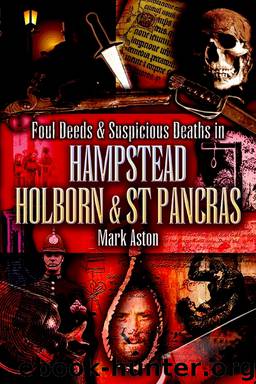Foul Deeds and Suspicious Deaths in Hampstead, Holburn and St Pancras by Aston Mark

Author:Aston, Mark
Language: eng
Format: epub
ISBN: 9781783408283
Publisher: Wharncliffe
Published: 2013-05-31T16:00:00+00:00
4 Burton Crescent, 1903. Here, in 1878, seventy-four-year-old Rachel Samuels was murdered. Burton Crescent was renamed Cartwright Gardens in 1908.
Evidently, the victim’s house showed no sign of violent entry and therefore the investigators decided that Mrs Samuels must have known her attacker. It was further noted that nothing had seemingly been removed or disturbed and thus the crime was not, as first believed, ‘the offspring of a premeditated robbery.’
It was not long until a suspect was arrested for this somewhat cowardly crime. A former servant to the victim, Mary Donovan, was charged and appeared at Bow Street Magistrates’ Court. In attempting to explain the circumstantial evidence against her, Mary protested her innocence throughout the hearing. Although not being in the permanent employ of Mrs Samuels, the accused continued to visit the old lady and would occasionally act as her charwoman. It was proved that, on 11 December, she had visited number 4 Burton Crescent and had stayed as late as 8.30 pm. Mary did not return home but instead had gone to sleep in a nearby coffee shop, as she could not rouse anyone at home; her husband was a night watchman. She also had blood on her clothing and was found wearing a pair of boots once belonging to Mrs Samuels. The bloodstains, however, were too few and too slight to be conclusive and she claimed that her husband bought her the boots, a fact that he declined to confirm. Her explanation was hastily ignored by police, who were doubtless looking for an early conviction. With robbery as possible motive, Mary was charged with wilful murder but she was not to remain in custody for long. On 10 January 1879, at Bow Street Magistrates Court, and with the solely circumstantial evidence insufficient to commit her to trial, the case against the former servant came to an impotent conclusion and she was free to walk. Undoubtedly, many associated with the case continued to believe in Mary Donovan’s guilt and she herself would carry that burden of suspicion for the rest of her life. What was reassuring about Mary’s acquittal though was the advancement that jurisprudence had made by this time. Here, a comparison can be made with the earlier case of poor Eliza Fenning who, in 1815, was hanged following a conviction based upon the weakest of circumstantial evidence. If tried sixty-four years later, Eliza’s case would have been almost certainly dismissed (see Chapter 7). This, of course, would have been of little comfort to the relatives and friends of Rachel Samuels. Their disappointment over not securing the conviction of the person or persons responsible for her death was doubtless shared by those associated with another unsolved killing revealed just six months later. This proved to be a similar case involving another aged female and, as before, the charge of murder against the prime suspect was dismissed due to poor circumstantial evidence.
Download
This site does not store any files on its server. We only index and link to content provided by other sites. Please contact the content providers to delete copyright contents if any and email us, we'll remove relevant links or contents immediately.
Mindhunter: Inside the FBI's Elite Serial Crime Unit by John E. Douglas & Mark Olshaker(8708)
Wiseguy by Nicholas Pileggi(5323)
Hitman by Howie Carr(4830)
Room 212 by Kate Stewart(4741)
Secrecy World by Jake Bernstein(4394)
Killers of the Flower Moon: The Osage Murders and the Birth of the FBI by David Grann(4192)
Breaking Free by Rachel Jeffs(4013)
Papillon (English) by Henri Charrière(3914)
Killers of the Flower Moon by David Grann(3753)
Say Nothing by Patrick Radden Keefe(3730)
American Kingpin by Nick Bilton(3510)
The Secret Barrister by The Secret Barrister(3425)
Molly's Game: From Hollywood's Elite to Wall Street's Billionaire Boys Club, My High-Stakes Adventure in the World of Underground Poker by Molly Bloom(3338)
Mysteries by Colin Wilson(3253)
In Cold Blood by Truman Capote(3140)
I'll Be Gone in the Dark by Michelle McNamara(2890)
Signature in the Cell: DNA and the Evidence for Intelligent Design by Stephen C. Meyer(2879)
Rogue Trader by Leeson Nick(2830)
Bunk by Kevin Young(2809)
